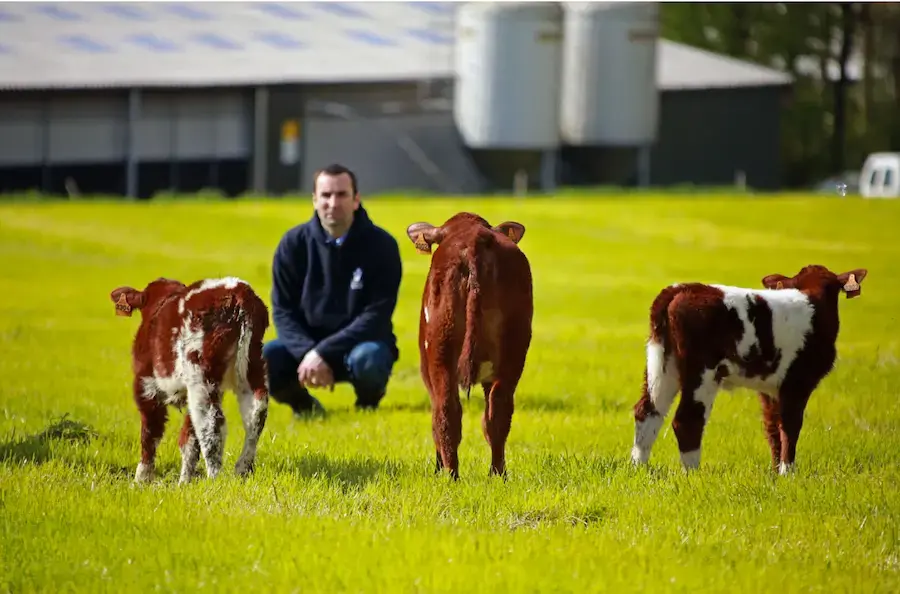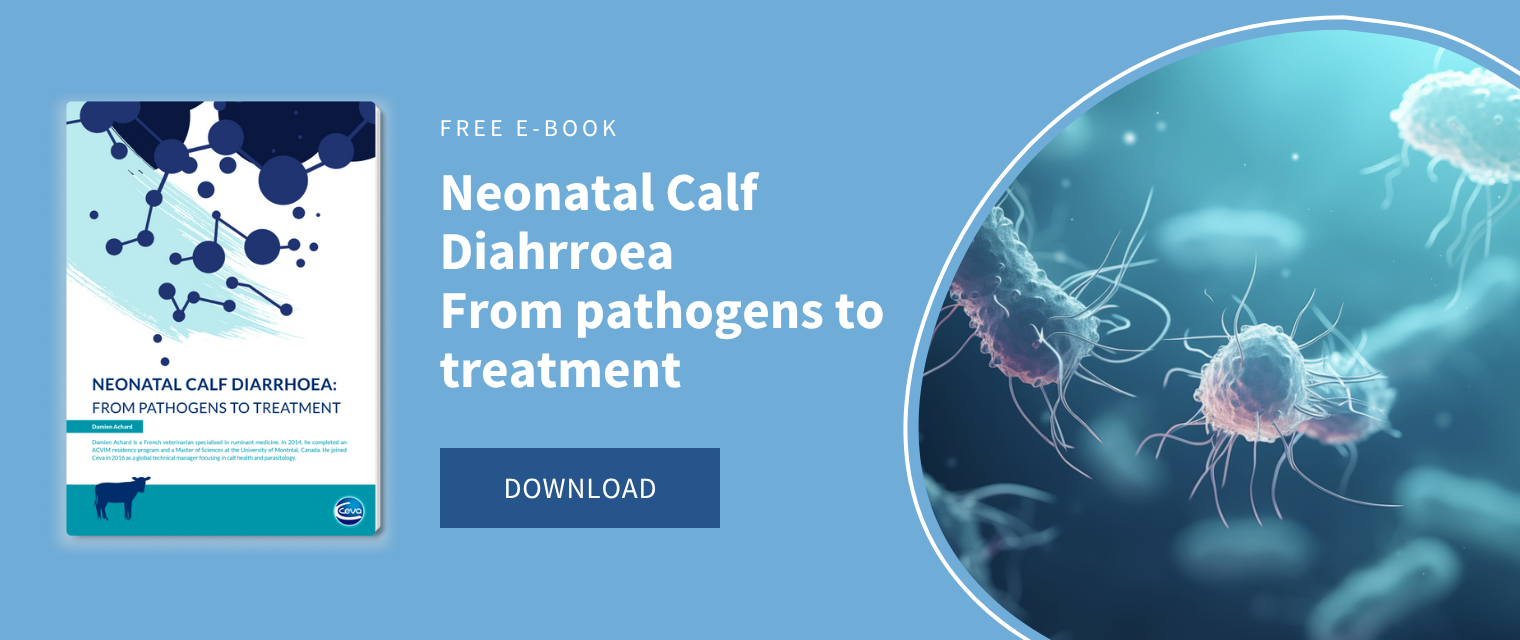With a global prevalence of 25% [1], cryptosporidiosis is a major disruptor of calf health around the world. In neonatal calves, cryptosporidiosis is caused by Cryptosporidium parvum, a zoonotic apicomplexan protozoan parasite which is one of the most frequent pathogens responsible for outbreaks of diarrhea. In this article, we will review the impacts of this endemic parasitic disease on calf health, including its effects on calf microbiota, and on growth performances.
Prefer to listen to this article? Click the play button below and enjoy our podcast!
 Cryptosporidiosis has a profound impact on calf health
Cryptosporidiosis has a profound impact on calf health
Cryptosporidiosis is commonly observed in neonatal calves within their first weeks of age. Older animals (calves of more than 3 weeks) appear to be less susceptible. C. parvum infection is associated with villous atrophy in the small intestine mucosa and alteration of the intestinal functions as reported in experimentally infected Holstein calves [2, 3]. Infected animals display reduced intestinal absorptive capacity as well as a large elevation of their intestinal permeability. All intestinal functions have been reported to be significantly affected up to day 14 post-infection under experimental conditions.
In addition, cryptosporidiosis induces changes in the intestinal microbiota of affected calves [4,5]. In experimentally challenged calves [4], a pronounced dysbiosis has been observed with a high prevalence of Clostridium species and number of exotoxins, adherence factors, and secretion systems related to Clostridium spp. and other enteropathogens (Campylobacter spp., Escherichia sp., Shigella spp., and Listeria spp). In two-week-old female dairy calves during acute cryptosporidiosis outbreak, decreased microbial diversity of faecal microbiota and high Fusobacterium abundancy were found [5].
C. parvum infection usually results in a severe diarrheic neutrophilic enterocolitis clinically characterized by a watery, profuse diarrhea that can last for up to two weeks [4]. Outbreaks with a high mortality in calves due to C. parvum have been reported [6]. The diarrhea, which is pale yellow with mucus, may occasionally contain strands of blood but in general is not haemorrhagic.

© Keidel and Daugschies, 2013
Calves are usually lethargic, anorexic, feverish and dehydrated but diarrhea can be the only clinical sign present. Dehydration associated with electrolyte and acid-base imbalances are responsible for metabolic acidosis which is typically observed in calves with cryptosporidiosis even when calves ‘general condition and suckling reflexes are good [7].
Infected calves appear to be more sensitive to other infections after recovery, e.g. bronchopneumonia, as suggested by a field study performed in male dairy calves for which calves that tested positive for C. parvum had a higher hazard (Hazard Ratio = 1.44) of being treated for respiratory disease [8].

Cryptosporidiosis compromises calves’ growth
Several studies have documented the impact of C. parvum infection in neonatal calves on their growth performances. In challenged calves, Klein et al. observed that the growth of the calves which had recovered from cryptosporidiosis was still affected 21 days after infection [2].

Similar conclusions were made in different settings of naturally occurring cryptosporidiosis [8, 9, 10]. In male dairy calves, Renaud et al. found that calves that tested positive for C. parvum had lower bodyweight at 49 days (−4.05 kg) and 77 days (−8.06 kg) after arrival at a grain-fed veal facility than calves that tested negative for C. parvum [8]. Similarly, the presence of C. parvum in diarrheic crossbred Nellore cattle was associated with a decrease in mean weight gain [9]. Finally, a field study performed in Scottish beef calves suggest that cryptosporidiosis do have a long-lasting impact on calf growth performances [10]. In their study, Shawn et al. reported an average difference in weight gain of 34 kg, at 6 months, between a group of calves that had severe cryptosporidiosis as neonates and a group of calves with no clinical signs of infection.
Conclusion
Cryptosporidiosis continues to have a profound impact on calf health across the globe as it frequently leads to multiple diarrheic episodes in multiple calves at the same time. In addition, cryptosporidiosis represents a significant financial burden to farmers due to labour costs, treatments, mortality losses and suboptimal growth associated with this endemic parasitic infection. This explains why cryptosporidiosis is still an important topic of discussion for farmers and veterinarians, notably to determine the best approaches for its control and treatment.
References
1. Buchanan R., Matechou E., Katzer F.D., Tsaousis A.D., Farre M. 2024. Global Prevalence of Cryptosporidium Infections in Cattle and C. parvum genotype distribution: A Meta-Analysis. bioRxiv doi: https://doi.org/10.1101/2024.07.16.603704
2. Klein P, Kleinová T, Volek Z, Simůnek J. Effect of Cryptosporidium parvum infection on the absorptive capacity and paracellular permeability of the small intestine in neonatal calves. Vet Parasitol. 2008 Mar 25;152(1-2):53-9. https://doi.org/10.1016/j.vetpar.2007.11.020
3. Robertson LJ, Björkman C, Axén C, Fayer R. Cryptosporidiosis in Farmed Animals. Cryptosporidium: parasite and disease. 2013 Aug 17:149–235. https://doi.org/10.1007/978-3-7091-1562-6_4
4. Gamsjäger L, Cirone KM, Schluessel S, Campsall M, Herik A, Lahiri P, Young D, Dufour A, Sapountzis P, Otani S, Gomez DE, Windeyer MC, Cobo ER. Host innate immune responses and microbiome profile of neonatal calves challenged with Cryptosporidium parvum and the effect of bovine colostrum supplementation. Front Cell Infect Microbiol. 2023 May 3;13:1165312. https://doi.org/10.3389/fcimb.2023.1165312
5. Dorbek-Kolin E, Husso A, Niku M, Loch M, Pessa-Morikawa T, Niine T, Kaart T, Iivanainen A, Orro T. Faecal microbiota in two-week-old female dairy calves during acute cryptosporidiosis outbreak - Association with systemic inflammatory response. Res Vet Sci. 2022 Dec 10;151:116-127. https://doi.org/10.1016/j.rvsc.2022.07.008
6. Niine T, Dorbek-Kolin E, Lassen B, Orro T. Cryptosporidium outbreak in calves on a large dairy farm: Effect of treatment and the association with the inflammatory response and short-term weight gain. Res Vet Sci. 2018 Apr;117:200-208. https://doi.org/10.1016/j.rvsc.2017.12.015
7. Kasap S., Kaçar Y., Sentürk S. Evaluation of blood gases in calves with Cryptosporidiosis. Large Animal Review, Vol 30, No 2, 2024.
8. Renaud DL, Rot C, Marshall J, Steele MA. The effect of Cryptosporidium parvum, rotavirus, and coronavirus infection on the health and performance of male dairy calves. J Dairy Sci. 2021 Feb;104(2):2151-2163. https://doi.org/10.3168/jds.2020-19215
9. B.S. Abreu, L.C. Pires, K.R. Santos, C.S.M. Luz, M.R.A. Oliveria, S.C. Sousa Junior. Occurrence of Cryptosporidium spp. and its association with ponderal development and diarrhoea episodes in Nellore mixed breed cattle. Acta Vet. Bras., 13 (2019), pp. 24-29.
10. Shaw HJ, Innes EA, Morrison LJ, Katzer F, Wells B. Long-term production effects of clinical cryptosporidiosis in neonatal calves. Int J Parasitol. 2020 May;50(5):371-376. https://doi.org/ 10.1016/j.ijpara.2020.03.002
About the author
Damien Achard (Ruminants Global Technical Manager)
Seasoned veterinarian, graduated from Ecole Nationale Vétérinaire de Nantes (France). After three years as a practitioner in central France, he pursued specialization in large animal internal medicine, completing an ACVIM residency and a Master of Sciences at the University of Montréal (2010-2014). Joining Semex Alliance as Health Manager for an IVF unit (2015-2016), he then transitioned to Ceva in 2016 as a Ruminants Global Technical Manager. Dr. Achard is an accomplished researcher, publishing on topics like downer cows, calf pneumonia or cryptosporidiosis and their associated therapies, and rational use of anthelmintics in ruminants. His ResearchGate profile (https://www.researchgate.net/profile/Damien-Achard/research) highlights his significant contributions to the veterinary field.
Explore author’s articles



Leave your comments here